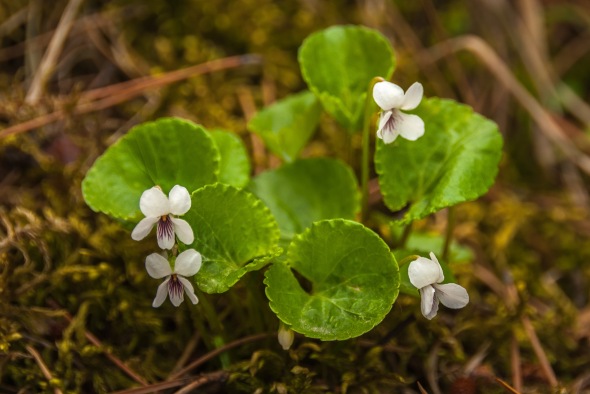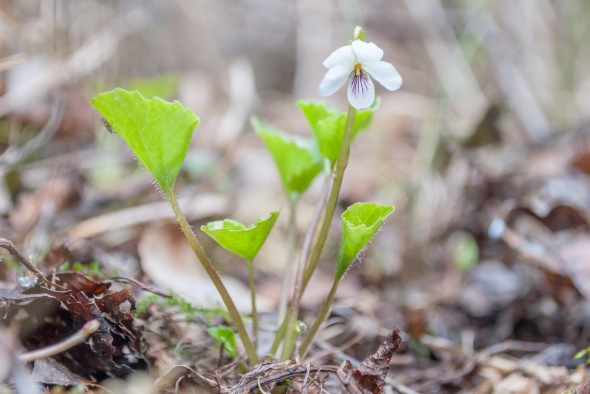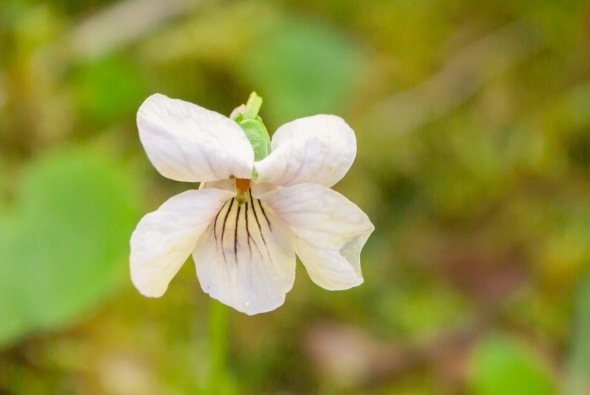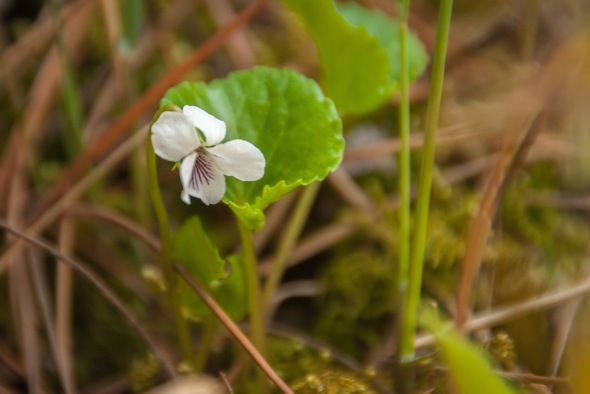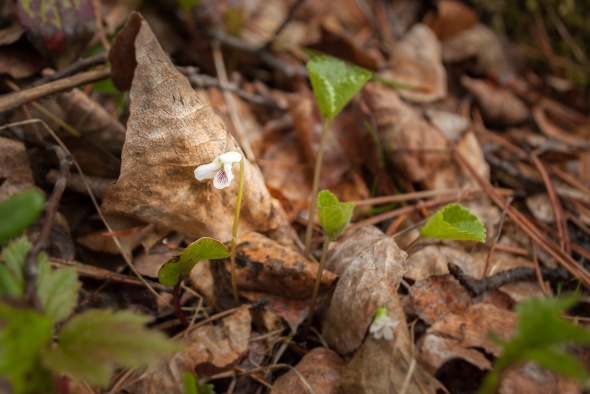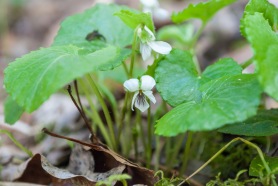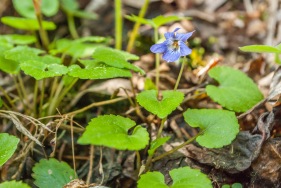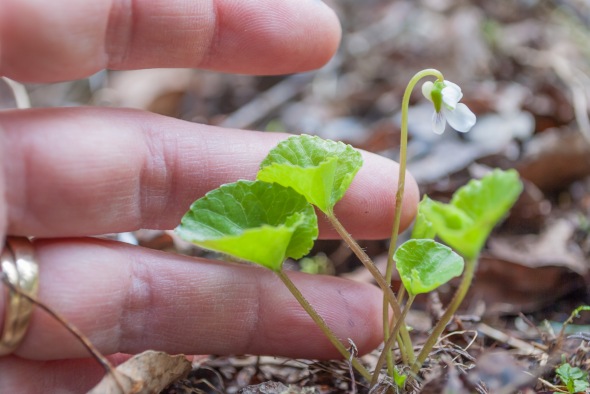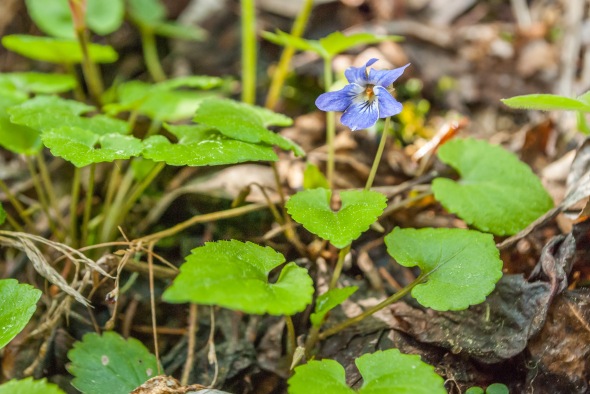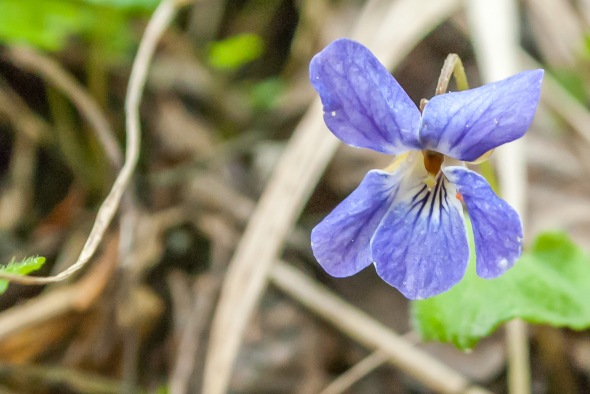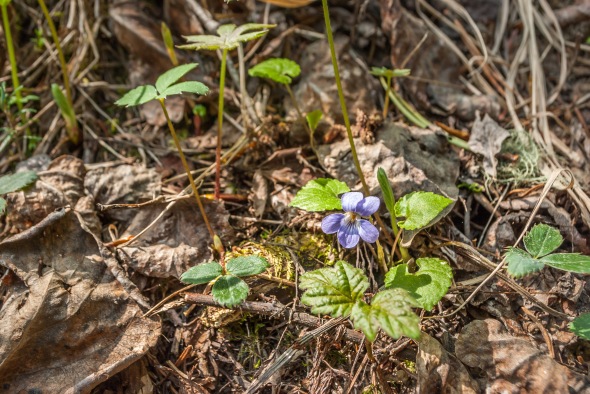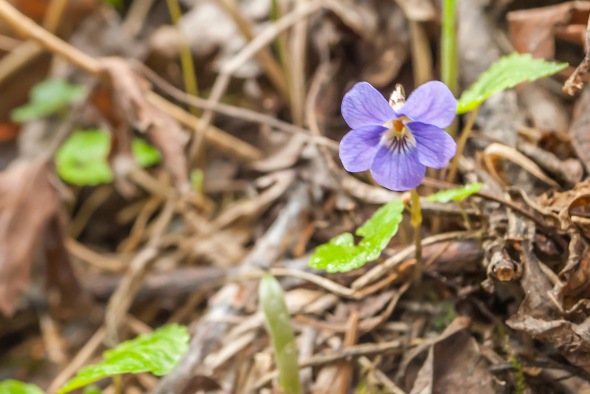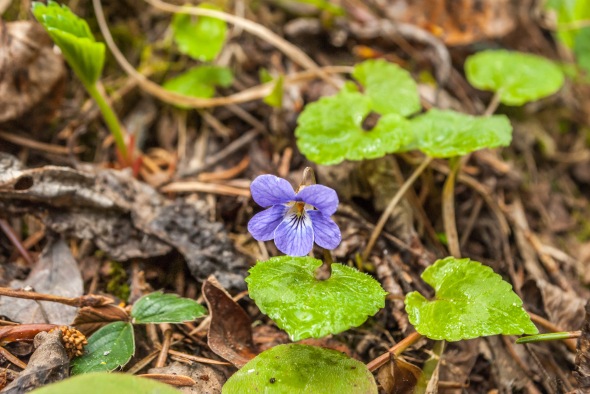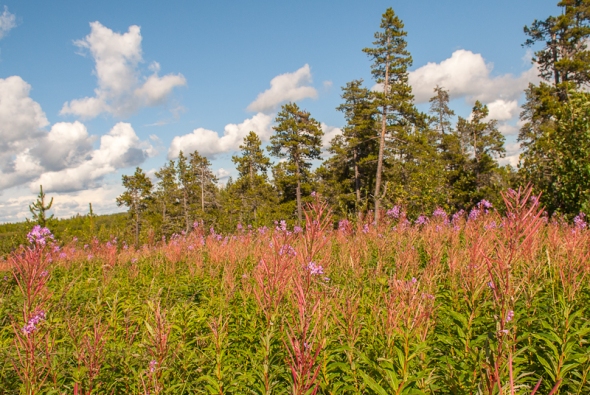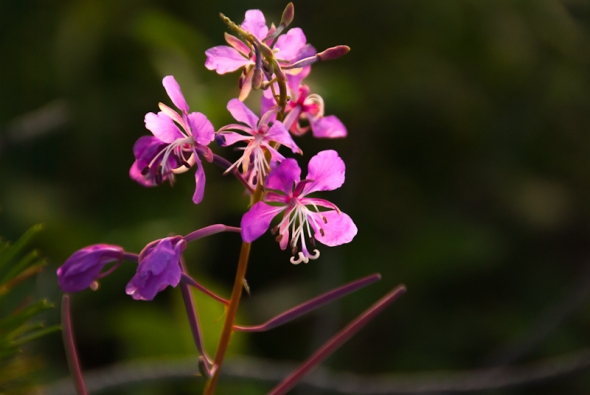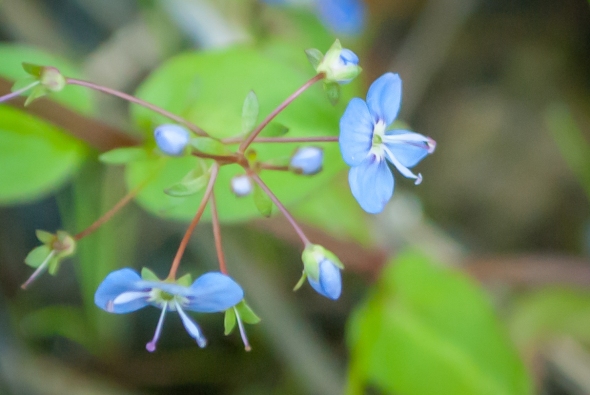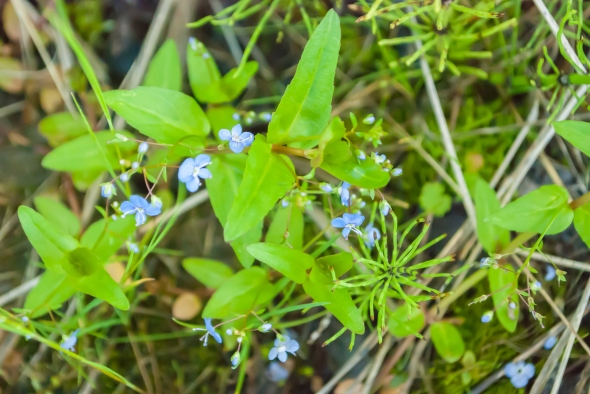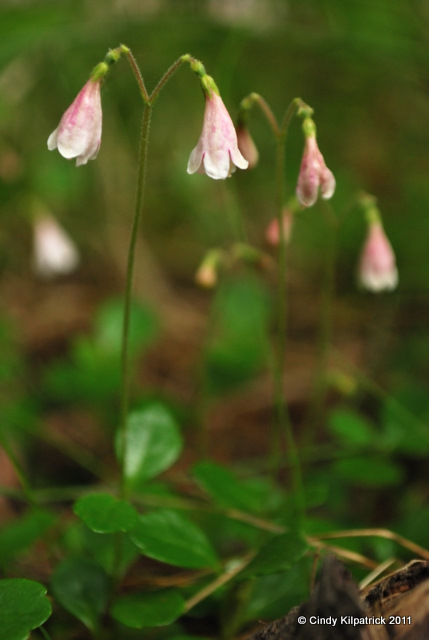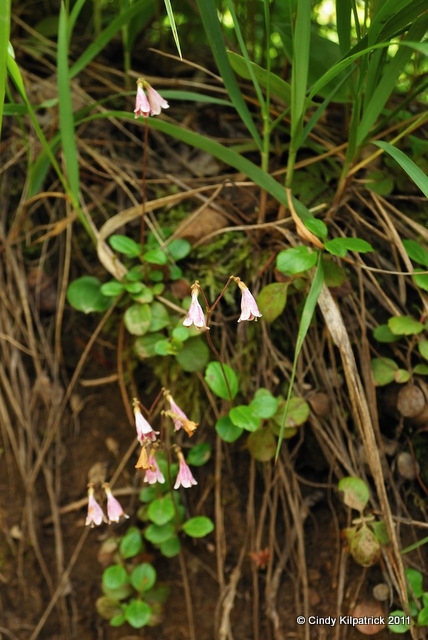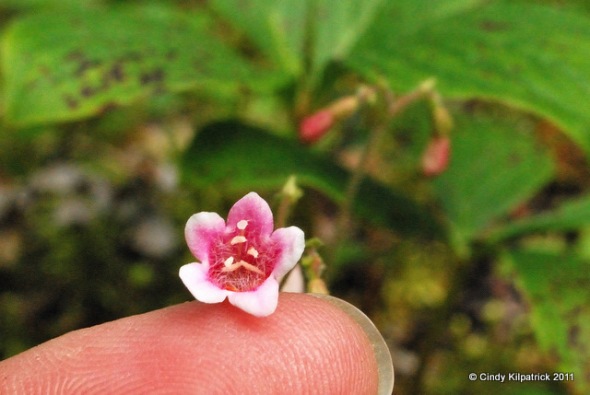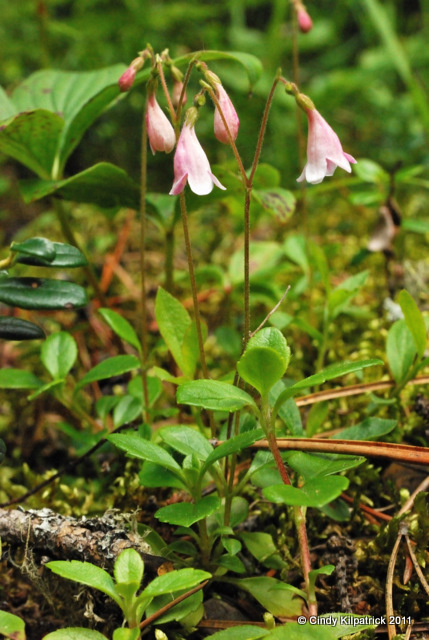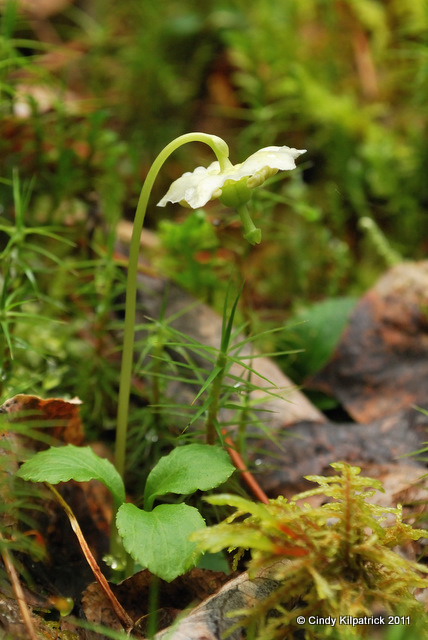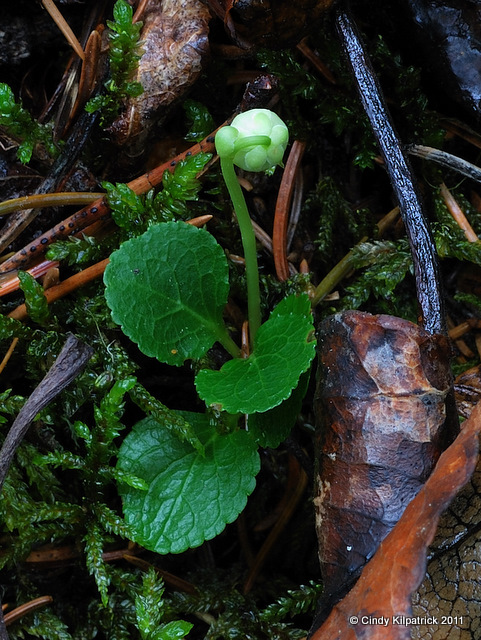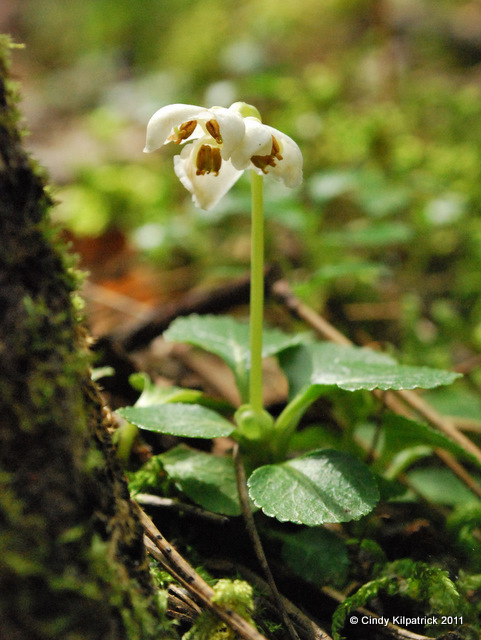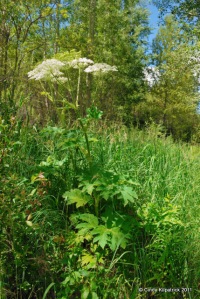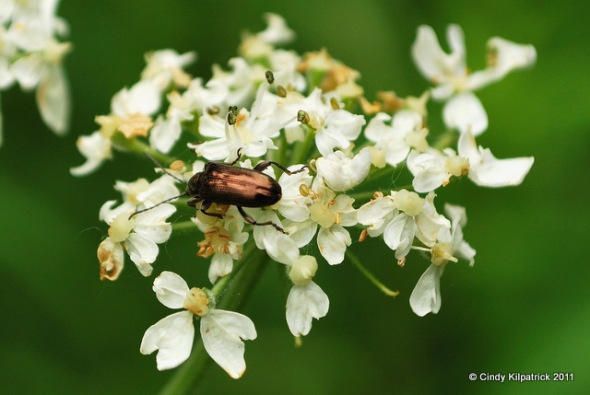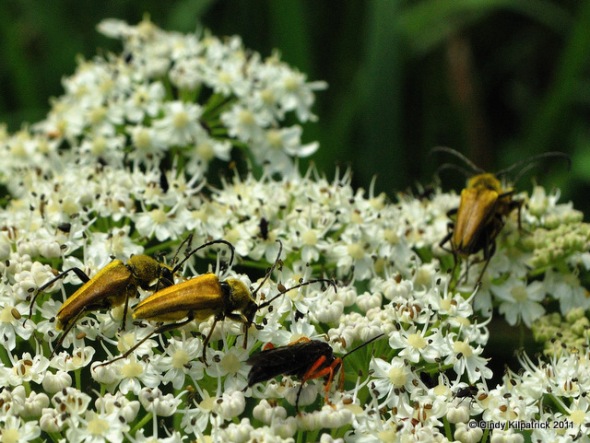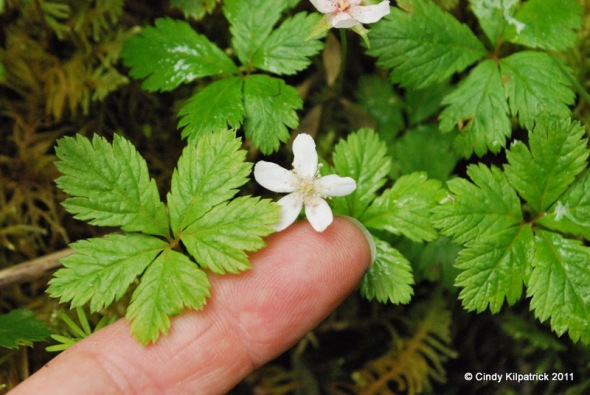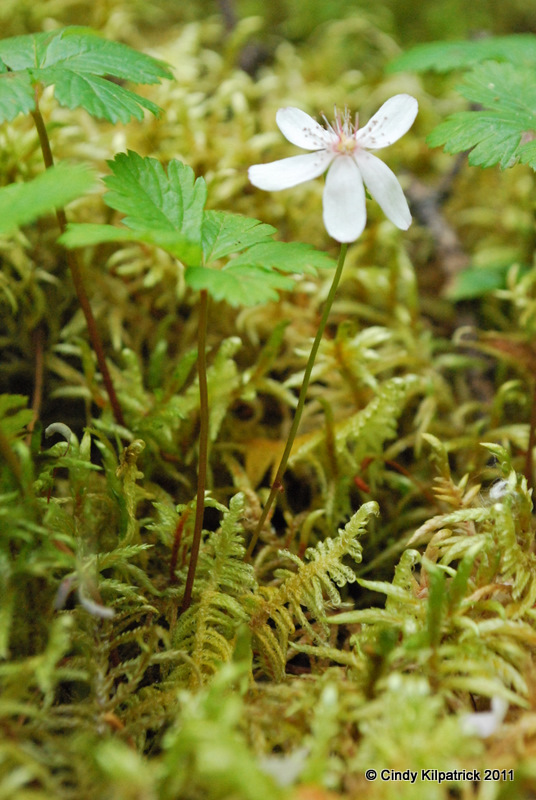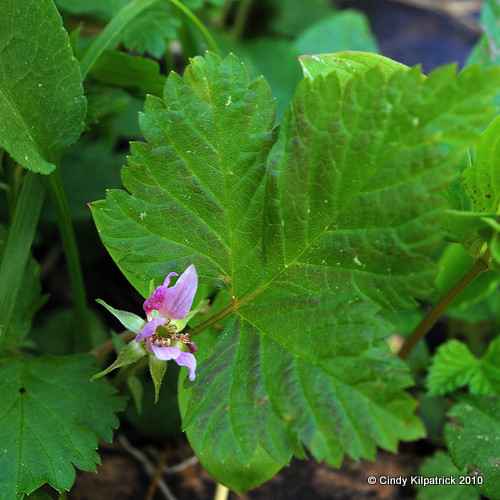Kidney-Leaved Violet
Viola renifolia A Gray
Also known as White Violet, Northern White Violet
Poking through moist leaf litter or deep moss, the Kidney-Leaved Violet is one of the first signs that spring has truly come to the hills. In the four years that I have photographed this little beauty, all images were taken between the last days of May and the end of June.
The species name renifolia refers to the kidney-shape of this violet’s leaves. They are further described as orbicular, or rounded-convex, and cordate, heart-shaped. (source) They are toothed and slightly hairy on the underside.
One of many violets native to North America, the Kidney-leaved violet can be found across Canada and south to the northern United States. Rising above the loose cluster of leaves, its flower is classic violet distinguished by its white colour with purple striping on its lip petal and wings (side petals), although most that I have found have very sparse striping on the wings or none at all. The stripes are thought to be guides for insects, encouraging them to push into the flower’s throat for nectar. V. renifolia has no beard to comb pollen from visiting insects and a very short spur.
Many violets produce a late-season flowers if the first blooms remain unfertilized. They bloom so soon after the snow has retreated from under the thick coniferous canopy that often pollinators are not yet active. These late blooms are closed and hidden and self-pollinating. Violet seeds are dispersed in small explosions and carried away by ants attracted to a special oil on their surface.
One half cup of violet leaves contains as much vitamin C as 4 oranges. They are also high in vitamin A. All above-ground parts of the violet are edible but the rhizomes, fruits and/or seeds of some are poisonous. The plant was used by the Cree in salves, tonics and as a (mildly laxative) relaxing tea. (source)
I can’t imagine gathering enough to do anything with, without wiping out entire populations. I have, however garnished the odd salad with ‘johnny-jump-ups’, which volunteer en masse in my garden.
Quandaries With Identification
Of three slightly different-looking violets that I’ve found in the local woods, the Kidney-Leaved Violet is the most abundant. It’s easily distinguished from the Early Blue Violet V. adunca by its white flowers. I’m less sure about one that might be Western Canada Violet, V. canadensis only because it has a point at the tip of it’s heart-shaped leaves. There are other features that make me less sure. A closer look next spring will hopefully tell.
‘My’ violets are very tiny but I’m not quite as concerned with this as sources vary in their estimation of leaf-width and plant height. (My finger behind the top leaf in the above image is about 12mm wide.)
There is also conflict in my resources as to whether this plant has rhisomes (link) or not (link) but I’m reluctant to dig one up to find out. I’m tempted to do a little scratching next spring however because the absence of stolons is apparently one of the best ways to distinguish it from V. pallens, which is listed in Rare Vascular Plants of Alberta by Kershaw et al. I don’t think it is though, because the ones I’ve photographed have leaves that are slightly hairy on the underside.
Selected Resources:
My flora books specifically linked in the text
NatureServe Explorer
USDA Plants Database
Early Blue Violet
Viola adunca
Other common names: Hookedspur Violet, Early Blue Violet, Sand Violet, and Western Dog Violet
O wind, where have you been,
That you blow so sweet?
Among the violets
Which blossom at your feet.The honeysuckle waits
For Summer and for heat
But violets in the chilly Spring
Make the turf so sweet.
Cristina (Georgina) Rossetti
Symbolizing the love of truth, or the truth of love, blue violets feature in many legends. They sprang from the blood of Greek god Attis and from where Orpheus laid his enchanted lute. Zeus created them for Io (the Greek word for violet) after turning her into a cow. Venus beat her rivals until they turned into violets and yet violets came to symbolize modesty or humility for Christians. In Iroquois legend, the first blue violets sprang from where the bodies of two lovers had fallen after being murdered by her people. (source)
Although I realize V. adunca may not have been the exact species to inspire the mythology and literary arts of the past, it’s easy to imagine how any of its sisters may have. I have, so far, only found them on one east-facing slope above a narrow forest ravine. And what a find! What joy to come upon these sparkles of blue among litter of the previous summer’s decaying cast-offs.
With wings lightly bearded at the pale, darkly penciled throat, the soft violet flower stands above juicy green leaves like a diminutive queen above her ladies laden with sustenance. There are at least 15 species of violets in Alberta, all beloved for their charming flowers in various shades of blue, yellow and white. What flower lover doesn’t recognize the five petaled princess: two petals in pairs at either side, a usually striped or penciled lower lip and a spur.
Not quite as widespread as V. renifolia, this North American species is still listed as secure. (link) It is a larval and/or nectar host for several butterflies (link).
The species name adunca refers to the Early Blue Violet’s hooked spur, which I haven’t (yet) succeeded in photographing.
More about violets in general can be found on the Kidney-Leaved Violet page.
Selected Resources:
My flora books specifically linked in the text
Northwestern Mountain Wildflowers
NatureServe
Montana Plant Life
University of Texas Native Plant Database
Fireweed

Epilobium angustifolium, also Chamerion angustifolium
Other common names: Great Willowherb, Rosebay Willowherb(GB), Blooming Sally, and Common, Perennial and Narrow-Leaved Fireweed
Fireweed is the floral emblem of the Yukon.
It grows throughout the temperate Northern Hemisphere.
Fireweed grows in my gardens.
I let it.
It’s beautiful.
The forty or so years since the forest was cleared to build my neighbourhood has not been enough to discourage this stalwart troop of botanical disaster relief. In fact generations would not be enough, as London discovered when firewood appeared to console and heal the (destroyed) city after World War II. It became known then as ‘Bombweed’ since it speedily transformed bomb craters into sunken gardens.
My garden is disturbed ground. A pioneer species, Fireweed appears wherever the earth has been scraped, or especially burned, leaving exposed soil and an open canopy letting in lots of light. Its rhizomes can extend to about 45 cm. deep, knitting and holding the soil, preventing erosion while other more slowly growing vegetation can become established. The rhizomes are so tenacious they often survive forest fires. They survived the 1980 Mount St. Helens eruption.
The flowers vary in colour from pink through purple and rarely white. They bloom on their raceme from the bottom to the top, transforming the profile of plant as they fade and morph into long curved seed-pods.
About 200-500 gossamer winged seeds are produced within each seedpod, up to 80,000 per plant. These seeds can survive up to two years – they do not go dormant – and can travel from 100-300 kilometres on their plumes in the right conditions.
In autumn, the first frosts paint the leaves a rich red, changing the swaths of purple-pink flowers to compliment the firey tamaracks and currant bushes.
Even the most botanically uninterested residents of Fireweed country recognize this plant once it’s in bloom, but in spring and fall it might help to remember that the Fireweed has a uniquely circular vein pattern on its narrow leaves. (The latin angusti, means narrow and folium, means leaf.)
Fireweed is very abundant in the Swan Hills, quickly colonizing after forest fires and logging. It has a relatively long blooming season and is an important source of nectar for honeybees and hummingbirds, and food for moose, deer and hares.
Yet another important role that Fireweed has played throughout its range is its historical importance as food and medicine. All parts are edible. The leaves contain Vitamin A & C and can be eaten fresh or cooked. Like most greens can become somewhat bitter with age. Be aware, though that over-indulgence can be slightly laxative for some people. Use of the flowers range from simple salad garnish to candies and the ambrosial Firewood honey has become a popular commercial product in Canada & Russia.
Medicinally the plant has been used for worm medicine, stomachaches and poultices. The Dena’ina mixed cooked plants into the food they gave to their sled dogs.
Fireweed is so abundant it has been put to such a humble use as surface for cleaning fish and probably rush-like flooring. The stem fibres were used as thread by many native North American peoples.
Even in winter and early spring this plant is recognizable, decorating the clearings with the intricate tracery of its remains.
Selected Resources:
U.S. Forestry Service Study (very detailed)
Northern Bushcraft: Foraging in the Pacific Northwest
Montana Plant Life
Plants for a Future
Plants of the Western Boreal and Aspen Parkland
Sweetness and Light
Alpine Speedwell
Veronica alpina or Veronica wormskjoldii – (I cannot confirm…see Pan-Arctic Flora for more confusion)
Also called American Alpine Speedwell and Alpine Veronica
Poking through tangled grasses and horsetails in the marshy ravine bottom, the tiny blue flowers catch the eye as they gather the blue of the sky to their four-parted corollas. The little cluster sits on the end of the stem like the coloured bead on the head of some of my dressmakers pins that have been bent and warped by my inept use on denim alterations. The delicate flower cluster seems out of proportion to the lanky and hairy stem with its well-spaced lance-shaped pairs of leaves.
Alpine Speedwell is not listed in my favourite plant book and I’ve had a hard time confirming the species. Superficially similar to another Veronica, American Brooklime, it distinguishes itself by its terminal flower cluster and stem-clasping leaves.
I have exhausted sources trying to specify this little plant’s exact identity but am leaning towards Veronica alpina subsp. pumila because of this qualifier:
“The differences between subsp. pumila and subsp. alpina are small but constant in stem usually flexuous vs. straight, upper internodes densely hairy with long (multicellular) hairs vs. sparsely hairy with minute hairs…” (source)
Online sources vary greatly in the species’ range and even its habitat. As well, apart from the comparison above, I have not found good botanical descriptions. As always, I welcome the input of any reader that can help me with this mystery.
Please see the post on a cousin, American Brooklime for details on the edibility and medicinal qualities of the this genus.
Other Selected Sources:
Ladybird Johnson Wildflower Centre
DemsterCountry Flora
USDA Plant Profile
American Brooklime
Veronica americana (alsoVeronica beccabunga ssp. americana)
Also called American Speedwell, Water Pimpernel
Gently semi-reclining in the shade at the marshy edge of the forest, like a delicate multi-headed princess posing in her mud-bath, American Brooklime soaks languid legs with such lassitude that they begin to take root at the supine nodes, anchoring the languid beauty even more firmly into the soggy soil. Displaying her paired stamens like alabaster eyelashes and drawing her colours from the ground, she paints her pretty four-lobed faces blue or violet, lilac or white, securing her prominence among the transition zone grasses and horsetails.
Looking closely at any plant’s many names and parts of names can reveal clues to its history, mythology, morphology and habitat. Veronicas are named for a Christian saint. ‘Americana’ denotes this plant’s status as a North American native. But most interestingly, I learned about a practice called ‘birdliming‘ as apparently ‘Brooklime’ came from this plant’s muddy habitat, which has been known to catch birds who are unfortunate enough to become mired in it. (You, on the other hand, might know about birdlime if you studied Othello: “I am about it, but indeed my invention/Comes from my pate as birdlime does from frieze…”.)
Botanary gives two possible origins of this perennial species’ peppy alternate name, beccabunga, which appears to refer to the European variety.
“Apparently derived from the German Bachbunge (brook+bunch), Another possible derivation is from the Flemish beckpunge (mouth smart), referring to the pungent leaves.”
All Veronicas are edible and high in vitamin C so were recognized early as a treatment for Scurvy. They have also been used for tea and tonics. Young plants can be added to salads, like watercress, but like many greens they become bitter as they age and should be cooked. Somewhat conflictingly, Brooklime was reportedly used by the Navajo Indians as an emetic (source) so I suspect that as in most things, moderation is the key. Gatherers must also be aware that the succulent stems contain the water that they grow in, so care must be taken to ensure that that water is safe.
American Brooklime is one of two Veronicas I have found in the Swan Hills area. The other is Alpine Speedwell.
Other Selected Sources:
Dr. Duke’s Phytochemical and Ethnobotanical Databases
Native American Ethnobotany
Twinflower
or Linnaea, Deer Vine, Ground Vine, Twin Sisters
Linnaea borealis
Delicate and diminutive, this distinctive member of the honeysuckle family grows with the moss among lingonberry and bunchberry. It spreads along the forest floor on lacy vines, sending up clonal shoots at intervals.The Dena’ina name for this sweetly fragrant plant is “k’ela tl’lia” or “mouse’s rope”, a fitting description of the meandering vines depicted well on this page.
This charming plant is circumpolar, but is distinguished by continent. It is interesting and perhaps a warning for other varieties that the subspecies borealis growing in Scotland is threatened by its increasing inability to reproduce due to the fragmentation of its ecosystem. (Read more here.) It is listed as threatened, endangered or extirpated through much of the United States. (link)
Twinflower was the favourite plant of Carlolus Linnaeus, who established the two-name (binomial) system of classification for plants. It was his teacher who officially named the genus, (whose only species member is the twinflower), after Linnaeus and when the latter scientist adopted it as his personal emblem, he said of it, “Linnaea was named by the celebrated Gronovius and is a plant of Lapland, lowly, insignificant, disregarded, flowering but for a brief time—from Linnaeus, who resembles it” (Wikipedia)
Blooming in the early to mid-summer, the elegant twinflower was used by First Nations people for a calming and healing tea. It likes partly shaded areas where the moss is moist and the shed evergreen needles acidify the humus somewhat.
He saw beneath dim aisles, in odorous beds,
The slight Linnaea hang its twin-born heads,
And blessed the monument of the man of flowers,
Which breathes his sweet fame through the northern bowers.
~~~~~~~~~~~~~~~~~~~~~~~~~~~~~~~~~~~~~~~~~~~~~~~~~~~~~~~~~~~~~~~~~~~~~~~~
Other resources:
Plants of the Western Boreal Forest & Aspen Parkland by Derek Johnson et al. Lone Pine, Alberta 1995
Wildflowers of Alberta by R.G.H. Cormack. Hurtig, Alberta 1977
Common Plants of the Western Rangelands: Volume 3 – Forbs by Kathy Tannas. Olds College, Alberta 2004
Wildflowers of the Canadian Rockies by George & Hälle Flygare. Hurtig, Alberta 1986
Yellow Marsh Marigold
or Marsh Marigold, Kingcup
Caltha palustris
While so many of our spring flowers are miniscule, the Marsh Marigold is a delight to discover in an open area by a sluggish stream. The plant itself is brilliant and showy with its large waxy leaves. Many a bowl of reassuring freshness has adorned spring tables through freezing nights and late snows.
It’s so scrumptious looking that you might be tempted to take a bite…but don’t! This entire plant is poisonous. It is toxic to the heart and can cause inflammation of the digestive organs. Handling the leaves can cause the skin to blister. The poison is volatile however and dried or cooked it is rendered harmless.
The spring blossoms of the marsh marigold have long been appreciated for their early colour. Like earthbound sunshine, patches of brilliant yellow set among shining green rise from brown and crumpled grasses in boggy roadside ditches and fens in early to mid June, as if beckoning returning waterfowl to potential, if not ideal nesting sites.
A polymorphic species, it occurs throughout the northern hemisphere in varied forms and goes by many names, most of which celebrate its welcome as a beautiful harbinger of spring. ‘Marigold’, used now over much of the modern english-speaking world, originated with Anglo-saxon celebrants of Easter, who gave the name to honour the Christian St. Mary.
By the end of July the waxy blossoms have done their work and the stellate seed clusters adorn the softened, but still handsome mound of leaves.
Depending on the source, the genus name ‘Caltha’ may refer to the colour or to the cup shape of the opening blossoms. Its species name, ‘palustris’, meaning ‘of the marsh’, clearly describes its habitat.
~~~~~~~~~~~~~~~~~~~~~~~~~~~~~~~~~~~~~~~~~~~~~~~~~~~~~~~~~~~~~~~~~~~~~~~~~~~~~~~
Other Resources:
Plants of the Western Boreal Forest & Aspen Parkland by Derek Johnson et al. Lone Pine, Alberta 1995
Wildflowers of Alberta by R.G.H. Cormack. Hurtig, Alberta 1977
Common Plants of the Western Rangelands: Volume 3 – Forbs by Kathy Tannas. Olds College, Alberta 2004
Caltha palustris on Wikipedia
Flora of the Canadian Arctic Archipelago
One-Flowered Wintergreen
or Single Delight, Woodnymph, Shy Maiden, St. Olaf’s Candlestick, Waxflower
Moneses uniflora (previously called Pyrola uniflora)
Until I began to research this sweet jewel, I did not know that one of its common names is ‘woodnymph’. How fitting, as like tiny waxen lanterns under the evergreens, the one-flowered wintergreen shine with soft luminescence. It is not difficult to imagine them dancing capriciously through the deep mosses when not observed by lesser mortals.
Another of its common names speaks to its habit of keeping its head bowed until mature. The shy maiden hides its beautiful face, providing shelter for visiting bees whose wings collect and deposit pollen in a process known as buzz-pollination.
After fertilization, the scapose (leafless) stem straightens, the petals fall off and the crowned fruit begins to form.
Like many native species, the one-flowered wintergreen depends on particular fungus occurring in the moist, humus-rich forest floor just as the pine and spruce provide required shade. Although it is globally abundant throughout boreal habitats, collection and forest harvest have caused its decline in some regions. It is reputed to be edible, high in Vitamin C and effective in the treatment of some skin problems. In recent years it was discovered to contain a new antibiotic.
Although the one-flowered wintergreen was originally grouped with others in the wintergreen family, it was distinguished in 1843 by Thomas Nutall to Moneses, a monotypic species. “Asa Gray gave it its present name in 1848. “Moneses” is a combination of the Greek “monos” (“one”) and “hesis” (“delight”).” (1) “Uniflora” refers to its lone blossom.
And delightful it is. Recline on the mossy bed. Lay your head next to this shy maiden to gaze into the surprisingly compelling face of intricate beauty. Then close your eyes and inhale the delicate perfume. You too may become enchanted.
~~~~~~~~~~~~~~~~~~~~~~~~~~~~~~~~~~~~~~~~~~~~~~~~~~~~~~~~~~~~~~~~~~~~~~~~~~~~~~
Other Resources:
Plants of the Western Boreal Forest & Aspen Parkland by Derek Johnson et al. Lone Pine, Alberta 1995
Wildflowers of Alberta by R.G.H. Cormack. Hurtig, Alberta 1977
Common Plants of the Western Rangelands: Volume 3 – Forbs by Kathy Tannas. Olds College, Alberta 2004
CYSIP (Central Yukon Species Inventory Project)
U.S. Forest Service
The Plant Network
Colorado Native Plant Society
Cow Parsnip
or Common Hogweed
Heracleum lanatum (also H. maximum, H. sphondylium)
According to Botanary, this genus of the carrot family was named for Hercules, who was supposed to have used it first for medicine.
This odoriferous species is indeed a plant of muscle: important and commanding as probably the largest perennial in our forest.
It grows in rich moist soil in broad and small forest clearings, rising up to almost two metres by July.
Its huge, 30 cm. compound hairy (lanatus) leaves and equally large flower heads provide landing plantforms and important sustinence for a wide range of insects and birds.
In contradiction to its name and in spite its nutritious foliage, Cow Parsnip is often shunned by cattle and can apparently have a souring effect on their milk when they do eat it. Bears have apparently been known to browse on the flower heads in the spring and in the fall the winged, sunflower-like seeds are popular with birds. After the frost, deer, elk, bears and marmots will eat the stems and leaves.
Roots, young leaf stalks and marrow from the hollow stem were used as food, for rituals, as a yellow dye and medicinally by the North American First Nations and early Europeans although care was taken as sensitive skin can be affected a phototoxin contained in the roots and outer skin.
If you are going to handle Cow Parsnip for any reason it is important that you do not confuse it with other plants of the carrot family that are quite poisonous. Gavan P.L. Watson from Ontario has a good description of the differences here.
~~~~~~~~~~~~~~~~~~~~~~~~~~~~~~~~~~~~~~~~~~~~~~~~~~~~~~~~~~~~~~~~~~~~~~~~~~~~~
Other Resources:
Plants of the Western Boreal Forest & Aspen Parkland by Derek Johnson et al. Lone Pine, Alberta 1995
Wildflowers of Alberta by R.G.H. Cormack. Hurtig, Alberta 1977
Common Plants of the Western Rangelands: Volume 3 – Forbs by Kathy Tannas. Olds College, Alberta 2004
All News in One
Montana Plant Life
Wild Food Girl
Strawberryleaf Raspberry
Rubus pedatus
~ also called Strawberry Bramble, 5-Leaved Bramble and Creeping Raspberry
I’m the kind of person that can have an engaging conversation with you and not be able to tell somebody later what you were wearing, so it was especially exciting for me when I noticed this little plant in a small deep-moss clearing. It’s not so much that I’d never seen it before, it’s that I’d never really seen it!
Perhaps I had never seen it in bloom and may have mistaken its foliage for that of one of its cousins, the Dwarf Raspberry. In bloom I might have assumed that it was another relative, the Wild Strawberry. It’s very tiny.
A closer look reveals that this flower is quite different from a strawberry’s. The petals are more elongated and the centre was different. It had three very distinct superior ovaries with styles that turn pink along with the base of the petals and sepals as the flower matures.
The sepals are drooping at first, as you can see in the top picture and then in more mature blooms raised level below the petals. As the petals fall off it seems they continue to rise to enclose the fruit.
Single leaf and flower stalk emerge separately from the moss, about 5-7 centimetres high.
The leaves were different as well. At first I thought it had five leaflets on its palmately divided leaf, but the side leaflets are just so deeply cleft that there are actually only three.
Apparently the number of ovaries can vary as the fruit can have from 1-6 drupelets.
I had a really hard time identifying this plant. I couldn’t find it in any of my books, or through Internet searching so I posted it to a couple of groups on Flickr that help with this kind of thing. The following day I was very grateful to receive a positive ID from Tiggrx. I later found it in Wildflowers of Alberta by R.G.H. Cormack (Hurtig 1977) as a note within the description for the Dewberry.
There are literally hundreds of plants in the Rubus genus, which it is believed has survived for some 36,000 years and exists on all continents except Antarctica. This little treasure is just another little sibling in the family and I don’t know how long I’ve been rudely ignoring it. It is a beauty. It fully deserves the risk of getting a little damp as you lay down in the soft deep moss to spend some time getting to know it better.
~~~~~~~~~~~~~~~~~~~~~~~~~~~~~~~~~~~~~~~~~~~~~~~~~~~~~~~~~~~~~~~~~~~~~~~~~~~~~~
Resources:
Turner Photographics
E-Flora BC
USDA Plants Database
Many thanks to Tiggrx for identifying this plant for me.
Red & White Baneberry
Actaea rubra
“The generic name Actaea is derived from the Greek aktiai, meaning elder, to which the leaves bear resemblance; rubra alluding to the red berries…” (source)
Most of the sources I’ve found say that the berries can also be white, although Ontario Wildflowers lists the white baneberry as a separate species (A. pachypoda). There are some good photos on that site as well, although their description of the berries of the red baneberry as ‘china white’ is a little confusing.
All parts of this member of the buttercup family are poisonous although several sources claim that native people did use it medicinally. “The name Baneberry refers to the plant’s toxicity, being derived from the Anglo-Saxon word for ‘murderous’ – bana.” (source)
It is apparently quite unpalatable, and there have been no reported deaths from it in North America. The European species has been linked to the deaths of children. (source) Some birds and small animals are able to digest it.
Dwarf Raspberry
Dwarf or Stemless Raspberry / Dwarf Nagoonberry ( Rubus acaulis)
Though small, you’re not likely to miss this little treasure in the woods. The flower is brilliant pink and stands proudly above the shiny, textured leaves.
The delicious berries, however are a little more difficult to find, possibly because critters found them before you but also because they’re quite tiny – about 1cm. Indeed, they’re so good that I usually forget to take a picture before I eat them. 🙂

